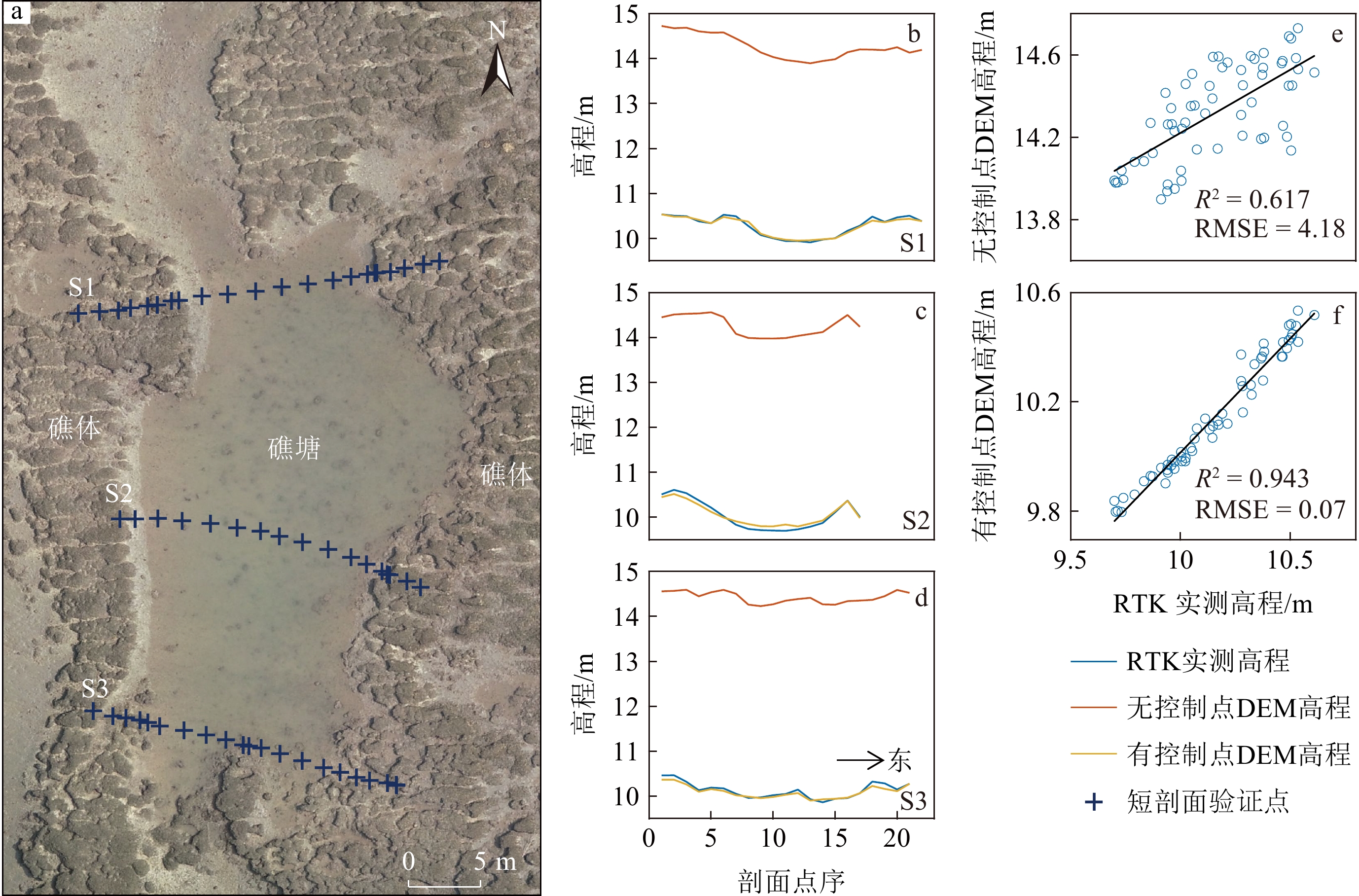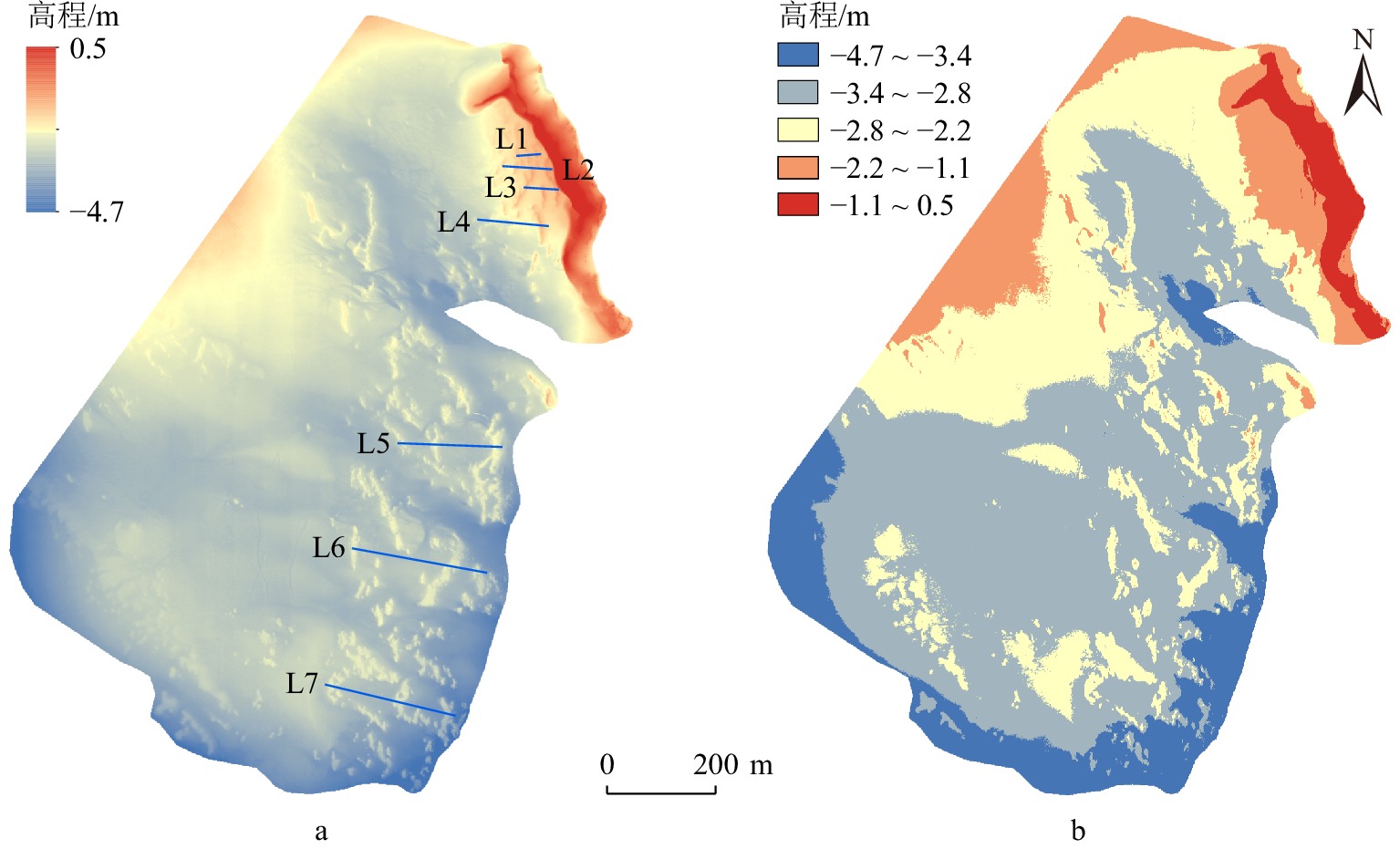Geomorphological survey of intertidal oyster reefs based on UAV Structure-from-Motion photogrammetry
-
摘要:
牡蛎礁是一种重要的海岸地貌系统,礁体的空间分布格局,深刻影响着周围的水动力和沉积动力过程,进而反作用于牡蛎礁自身演化。江苏海门蛎蚜山牡蛎礁为中国海岸重要且稀有的生态系统,近年来,沉积物覆盖和人为捕捞导致牡蛎礁退化严重。本文利用无人机对蛎蚜山牡蛎礁进行地貌观测,基于运动恢复结构(SfM,Structure from Motion)摄影测量技术重建出航拍区域的高分辨率三维模型,包括正射影像和数字高程模型(DEM),并对重建的模型进行目视解译和剖面分析。结果表明,位于航拍区域的牡蛎礁主要有三种形态:条带状、斑块状和环状。条带状牡蛎礁脊线整体上呈南北走向,可能由环状牡蛎礁退化或牡蛎的生物自组织过程形成。航拍区域的地貌面高差可达5 m以上,地势最高处高程为0.5 m(85高程,下同),最低处高程为−4.7 m。礁区内的礁体仍处于退化状态,其演化过程主要为:礁体表面出现坑洼→坑洼进一步扩张、延伸→形成溶槽→礁体分隔、分解,同时伴有沉积物对礁体的掩埋。本研究表明,无人机SfM技术可以高效获取牡蛎礁的地貌信息,为研究牡蛎礁演化过程提供了有力支持。
Abstract:Oyster reefs is an important coastal morphological system, the spatial distribution pattern of the reefs profoundly influences the surrounding hydrodynamic and sedimentary processes, which in turn affects the evolution of oyster reefs. The Liyashan oyster reef in Haimen, Jiangsu, is an important and rare ecosystem in the Chinese coast; however, it has been seriously degraded by sediment cover and human fishing in recent years. A geomorphological observation of the oyster reefs in Liyashan was carried out using an unmanned aerial vehicle (UAV). Based on the SfM (Structure from Motion) photogrammetry, high-resolution three-dimensional models of the aerial photography region were reconstructed, including orthophoto and digital elevation model (DEM). Then, the visual interpretation and profile analysis on the reconstructed models were conducted. Results show that the oyster reefs are mainly composed of three types in distribution shape: string, patch, and ring. The “string” oyster reef ridges are generally oriented north-south, likely were formed by the degradation of “ring” reefs or self-organization process of oysters. The elevation differences within the surveyed area could reach more than 5 m, the highest elevation was 0.5 m (1985 national elevation), while the lowest elevation was −4.7 m. The reefs are still in a degraded state, and the evolutionary process is mainly as follows: potholes appear on the surfaces of the reefs → further expansion and extension of potholes → formation of grooves→ segmentation and disintegration of the reefs, accompanied by sedimentary burial of the reefs. This study shows that the UAV SfM technique can efficiently obtain geomorphological data of oyster reefs, which provides a strong support for studying the evolution of oyster reefs.
-

-
[1] Coen L D, Luckenbach M W. Developing success criteria and goals for evaluating oyster reef restoration: ecological function or resource exploitation?[J]. Ecological Engineering, 2000, 15(3-4):323-343. doi: 10.1016/S0925-8574(00)00084-7
[2] Chambers L G, Gaspar S A, Pilato C J, et al. How well do restored intertidal oyster reefs support key biogeochemical properties in a coastal lagoon?[J]. Estuaries and Coasts, 2018, 41(3):784-799. doi: 10.1007/s12237-017-0311-5
[3] Cressman K A, Posey M H, Mallin M A, et al. Effects of oyster reefs on water quality in a tidal creek estuary[J]. Journal of Shellfish Research, 2003, 22(3):753-762.
[4] Piazza B P, Banks P D, La Peyre M K. The potential for created oyster shell reefs as a sustainable shoreline protection strategy in Louisiana[J]. Restoration Ecology, 2005, 13(3):499-506. doi: 10.1111/j.1526-100X.2005.00062.x
[5] Scyphers S B, Powers S P, Heck Jr K L, et al. Oyster reefs as natural breakwaters mitigate shoreline loss and facilitate fisheries[J]. PLoS One, 2011, 6(8):e22396. doi: 10.1371/journal.pone.0022396
[6] Quan W M, Zhu J X, Ni Y, et al. Faunal utilization of constructed intertidal oyster ( Crassostrea rivularis) reef in the Yangtze River estuary, China[J]. Ecological Engineering, 2009, 35(10):1466-1475. doi: 10.1016/j.ecoleng.2009.06.001
[7] Beck M W, Brumbaugh R D, Airoldi L, et al. Oyster reefs at risk and recommendations for conservation, restoration, and management[J]. BioScience, 2011, 61(2):107-116. doi: 10.1525/bio.2011.61.2.5
[8] Brumbaugh R D, Coen L D. Contemporary approaches for small-scale oyster reef restoration to address substrate versus recruitment limitation: a review and comments relevant for the Olympia oyster, Ostrea lurida Carpenter 1864[J]. Journal of Shellfish Research, 2009, 28(1):147-161. doi: 10.2983/035.028.0105
[9] Jackson J B C, Kirby M X, Berger W H, et al. Historical overfishing and the recent collapse of coastal ecosystems[J]. Science, 2001, 293(5530):629-637. doi: 10.1126/science.1059199
[10] 张忍顺. 江苏小庙洪牡蛎礁的地貌-沉积特征[J]. 海洋与湖沼, 2004, 35(1):1-7 doi: 10.3321/j.issn:0029-814X.2004.01.001
ZHANG Renshun. The geomorphology-sedimentology character of oyster reef in Xiaomiaohong tidal channel, Jiangsu province[J]. Oceanologia et Limnologia Sinica, 2004, 35(1):1-7. doi: 10.3321/j.issn:0029-814X.2004.01.001
[11] 张忍顺, 王艳红, 张正龙, 等. 江苏小庙洪牡蛎礁的地貌特征及演化[J]. 海洋与湖沼, 2007, 38(3):259-265 doi: 10.3321/j.issn:0029-814X.2007.03.012
ZHANG Renshun, WANG Yanhong, ZHANG Zhenglong, et al. Geomorphology and evolution of the Xiaomiaohong oyster reef off Jiangsu coast, China[J]. Oceanologia et Limnologia Sinica, 2007, 38(3):259-265. doi: 10.3321/j.issn:0029-814X.2007.03.012
[12] Colden A M, Fall K A, Cartwright G M, et al. Sediment suspension and deposition across restored oyster reefs of varying orientation to flow: implications for restoration[J]. Estuaries and Coasts, 2016, 39(5):1435-1448. doi: 10.1007/s12237-016-0096-y
[13] Grave C. Investigations for the Promotion of the Oyster Industry of North Carolina[M]. Washington: US Government Printing Office, 1904.
[14] Kennedy V S, Sanford L P. The morphology and physical oceanography of unexploited oyster reefs in North America[M]//Luckenbach M W, Mann R, Wesson J A. Oyster Reef Habitat Restoration: A Synopsis and Synthesis of Approaches. Gloucester Point: VIMS Press, 1999: 25-46.
[15] Smith G F, Roach E B, Bruce D G. The location, composition, and origin of oyster bars in mesohaline Chesapeake Bay[J]. Estuarine, Coastal and Shelf Science, 2003, 56(2):391-409. doi: 10.1016/S0272-7714(02)00191-9
[16] Walles B, Salvador de Paiva J, van Prooijen B C, et al. The ecosystem engineer Crassostrea gigas affects tidal flat morphology beyond the boundary of their reef structures[J]. Estuaries and Coasts, 2015, 38(3):941-950. doi: 10.1007/s12237-014-9860-z
[17] Woods H, HARGIS W J, Hershner C H, et al. Disappearance of the natural emergent 3-dimensional oyster reef system of the James River, Virginia, 1871-1948[J]. Journal of Shellfish Research, 2005, 24(1):139-142. doi: 10.2983/0730-8000(2005)24[139:DOTNED]2.0.CO;2
[18] Lenihan H S. Physical–biological coupling on oyster reefs: how habitat structure influences individual performance[J]. Ecological Monographs, 1999, 69(3):251-275.
[19] Koppel J, Rietkerk M, Dankers N, et al. Scale-dependent feedback and regular spatial patterns in young mussel beds[J]. The American Naturalist, 2005, 165(3):E66-E77. doi: 10.1086/428362
[20] van de Koppel J, Bouma T J, Herman P M J. The influence of local-and landscape-scale processes on spatial self-organization in estuarine ecosystems[J]. Journal of Experimental Biology, 2012, 215(6):962-967. doi: 10.1242/jeb.060467
[21] Ysebaert T, Walles B, Haner J, et al. Habitat modification and coastal protection by ecosystem-engineering reef-building bivalves[M]//Smaal A C, Ferreira J G, Grant J, et al. Goods and Services of Marine Bivalves. Cham: Springer, 2019: 253-273.
[22] Grabowski J H, Brumbaugh R D, Conrad R F, et al. Economic valuation of ecosystem services provided by oyster reefs[J]. Bioscience, 2012, 62(10):900-909. doi: 10.1525/bio.2012.62.10.10
[23] Zu Ermgassen P S E, Spalding M D, Grizzle R E, et al. Quantifying the loss of a marine ecosystem service: filtration by the eastern oyster in US estuaries[J]. Estuaries and Coasts, 2013, 36(1):36-43. doi: 10.1007/s12237-012-9559-y
[24] Baggett L P, Powers S P, Brumbaugh R D, et al. Guidelines for evaluating performance of oyster habitat restoration[J]. Restoration Ecology, 2015, 23(6):737-745. doi: 10.1111/rec.12262
[25] Barillé L, Prou J, Héral M, et al. Effects of high natural seston concentrations on the feeding, selection, and absorption of the oyster Crassostrea gigas (Thunberg)[J]. Journal of Experimental Marine Biology and Ecology, 1997, 212(2):149-172. doi: 10.1016/S0022-0981(96)02756-6
[26] Gernez P, Barillé L, Lerouxel A, et al. Remote sensing of suspended particulate matter in turbid oyster‐farming ecosystems[J]. Journal of Geophysical Research:Oceans, 2014, 119(10):7277-7294. doi: 10.1002/2014JC010055
[27] Huang W R, Hagen S C, Wang D B, et al. Suspended sediment projections in Apalachicola Bay in response to altered river flow and sediment loads under climate change and sea level rise[J]. Earth's Future, 2016, 4(10):428-439. doi: 10.1002/2016EF000384
[28] Windle A E, Poulin S K, Johnston D W, et al. Rapid and accurate monitoring of intertidal Oyster Reef Habitat using unoccupied aircraft systems and structure from motion[J]. Remote Sensing, 2019, 11(20):2394. doi: 10.3390/rs11202394
[29] Baggett L P, Powers S P, Brumbaugh R, et al. Oyster Habitat Restoration Monitoring and Assessment Handbook[M]. Arlington: The Nature Conservancy, 2014.
[30] Power A, Corley B, Atkinson D, et al. A caution against interpreting and quantifying oyster habitat loss from historical surveys[J]. Journal of Shellfish Research, 2010, 29(4):927-936. doi: 10.2983/035.029.0425
[31] Schill S R, Porter D E, Coen L D, et al. Development of an automated mapping technique for monitoring and managing shellfish distributions. A final report submitted to: NOAA/UNH cooperative institute for coastal and estuarine environmental technology (CICEET)[R]. Port Norris, 2006: 91.
[32] Rodriguez A B, Fodrie F J, Ridge J T, et al. Oyster reefs can outpace sea-level rise[J]. Nature Climate Change, 2014, 4(6):493-497. doi: 10.1038/nclimate2216
[33] Mancini F, Dubbini M, Gattelli M, et al. Using unmanned aerial vehicles (UAV) for high-resolution reconstruction of topography: the structure from motion approach on coastal environments[J]. Remote Sensing, 2013, 5(12):6880-6898. doi: 10.3390/rs5126880
[34] 全为民, 周为峰, 马春艳, 等. 江苏海门蛎岈山牡蛎礁生态现状评价[J]. 生态学报, 2016, 36(23):7749-7757
QUAN Weimin, ZHOU Weifeng, MA Chunyan, et al. Ecological status of a natural intertidal oyster reef in Haimen County, Jiangsu province[J]. Acta Ecologica Sinica, 2016, 36(23):7749-7757.
[35] Lin H J, Yu Q, Wang Y W, et al. Identification, extraction and interpretation of Multi-Period variations of coastal suspended sediment concentration based on unevenly spaced observations[J]. Marine Geology, 2022, 445:106732. doi: 10.1016/j.margeo.2022.106732
[36] Lin H J, Yu Q, Du Z Y, et al. Geomorphology and sediment dynamics of the Liyashan oyster reefs, Jiangsu Coast, China[J]. Acta Oceanologica Sinica, 2021, 40(10):118-128. doi: 10.1007/s13131-021-1866-3
[37] 全为民, 安传光, 马春艳, 等. 江苏小庙洪牡蛎礁大型底栖动物多样性及群落结构[J]. 海洋与湖沼, 2012, 43(5):992-1000 doi: 10.11693/hyhz201205017017
QUAN Weimin, AN Chuanguang, MA Chunyan, et al. Biodiversity and community structure of benthic macroinvertebrates on the Xiaomiaohong oyster reef in Jiangsu province, China[J]. Oceanologia et Limnologia Sinica, 2012, 43(5):992-1000. doi: 10.11693/hyhz201205017017
[38] 任美锷, 丁方叔, 万延森, 等. 江苏省海岸带和海涂资源综合调查报告[M]. 北京: 海洋出版社, 1986
REN Mei’e, DING Fangshu, WANG Yansen, et al. Comprehensive Survey of Coastal Zone and Intertidal Resources in Jiangsu Province: Report[M]. Beijing: China Ocean Press, 1986.
[39] Mian O, Lutes J, Lipa G, et al. Direct georeferencing on small unmanned aerial platforms for improved reliability and accuracy of mapping without the need for ground control points[C]//The International Archives of the Photogrammetry, Remote Sensing and Spatial Information Sciences. Toronto, 2015: 397-402.
[40] Brunier G, Michaud E, Fleury J, et al. Assessing the relationship between macro-faunal burrowing activity and mudflat geomorphology from UAV-based Structure-from-Motion photogrammetry[J]. Remote Sensing of Environment, 2020, 241:111717. doi: 10.1016/j.rse.2020.111717
[41] Taddia Y, Pellegrinelli A, Corbau C, et al. High-resolution monitoring of tidal systems using UAV: a case study on Poplar Island, MD (USA)[J]. Remote Sensing, 2021, 13(7):1364. doi: 10.3390/rs13071364
[42] Jaud M, Grasso F, Le Dantec N, et al. Potential of UAVs for monitoring mudflat morphodynamics (Application to the seine estuary, France)[J]. ISPRS International Journal of Geo-Information, 2016, 5(4):50. doi: 10.3390/ijgi5040050
[43] Sanz-Ablanedo E, Chandler J H, Rodríguez-Pérez J R, et al. Accuracy of unmanned aerial vehicle (UAV) and SfM photogrammetry survey as a function of the number and location of ground control points used[J]. Remote Sensing, 2018, 10(10):1606. doi: 10.3390/rs10101606
[44] Ridge J T, Gray P C, Windle A E, et al. Deep learning for coastal resource conservation: automating detection of shellfish reefs[J]. Remote Sensing in Ecology and Conservation, 2020, 6(4):431-440. doi: 10.1002/rse2.134
[45] Morris R L, La Peyre M K, Webb B M, et al. Large‐scale variation in wave attenuation of oyster reef living shorelines and the influence of inundation duration[J]. Ecological Applications, 2021, 31(6):e02382. doi: 10.1002/eap.2382
-




 下载:
下载:




